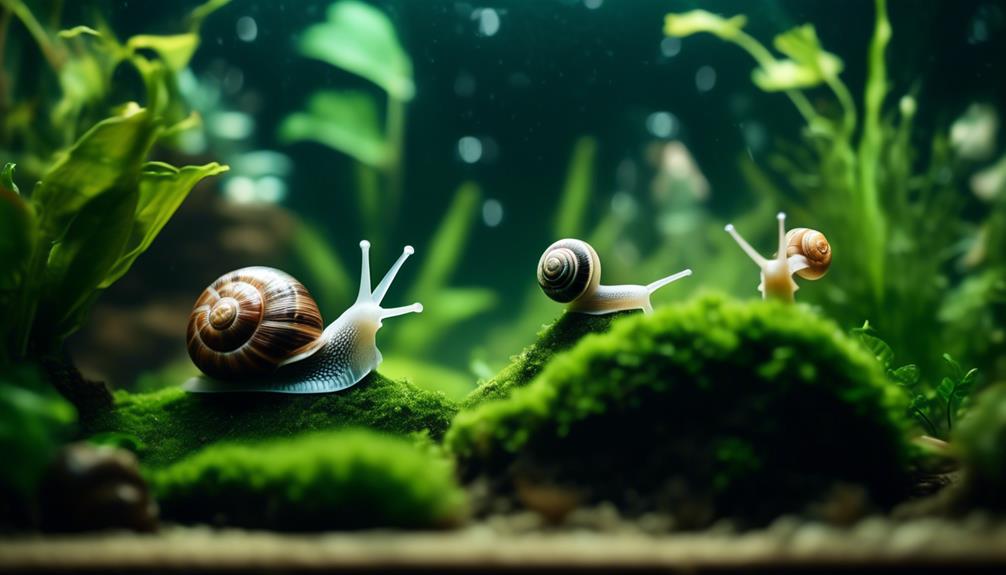When it comes to keeping an aquarium clean, finding the perfect cleaning crew can seem like an impossible task. However, there is one species that exceeds all expectations: the Mystery Snail.
These snails possess an extraordinary ability to rid your tank of debris and maintain a pristine environment. With their colorful shells and unique characteristics, Mystery Snails are not only efficient cleaners but also fascinating creatures to observe.
But what sets them apart from other snail species? And how do you properly care for them?
In this discussion, we will delve into the world of Mystery Snails and uncover why they are the ultimate aquarium cleaning crew.
Key Takeaways
- Mystery snails are excellent scavengers that clean up the aquarium.
- They require water with lots of calcium and minerals, with ideal parameters including temperature, pH, and GH levels.
- Mystery snails are not picky eaters, consuming fish food, algae, biofilm, and dead plants.
- Breeding mystery snails requires specific conditions and techniques, including sexing, conditioning, and providing space for egg laying.
Characteristics and Care Requirements
Mystery snails, known for their pointier tip and colorful shells, have specific care requirements that ensure their well-being in aquariums. Understanding their anatomy is crucial for providing proper care.
These snails have a muscular foot that helps them move and climb surfaces within the tank. They also possess a hard, spiraled shell that protects their soft body.
When it comes to tank mates, mystery snails are generally peaceful and can be kept with a variety of fish and invertebrates. However, caution should be exercised when housing them with aggressive or fin-nipping species. It's also important to provide enough space and hiding spots to prevent stress and territorial issues.
Diet and Feeding Habits
To meet the dietary needs of mystery snails in aquariums, it's important to understand their feeding habits and provide them with a diverse and nutrient-rich diet. Mystery snails aren't picky eaters and will consume fish food, algae, biofilm, dead fish, and dead plants. They can also eat duckweed and other small floating plants.
To ensure their health, it's recommended to feed them mineral-rich foods such as Hikari Crab Cuisine and calcium-rich vegetables. Snail jello recipes, also known as Snello, can be made using Repashy gel food mixed with calcium powder. These recipes provide a balanced and nutritious meal for mystery snails.
Preventing and Managing Breeding

To prevent and manage the breeding of mystery snails in aquariums, it's important to implement effective strategies and techniques.
Breeding control techniques can include keeping only one snail per aquarium, purchasing snails that are under 1 inch in diameter, and maintaining the water level within 1.5 inches from the top to prevent egg laying. Regularly checking for signs of breeding and promptly removing eggs is crucial.
Additionally, excess snails can be fed to snail eaters or sold to local fish stores or hobbyists, providing a way to control the population and prevent further breeding. Selling snails locally is a great way to not only manage breeding but also to serve others in the aquarium hobby community.
Breeding Mystery Snails
To effectively breed mystery snails in an aquarium, specific steps must be taken to ensure successful reproduction and the development of healthy offspring. Breeding techniques for mystery snails involve creating the best breeding conditions, which include providing a space for egg laying and maintaining a warm and humid environment for egg development. A floating breeder box can be used in the aquarium to separate the eggs from the adult snails and prevent accidental vacuuming of the hatchlings. It is important to rub the clutch gently to free the babies, while leaving the clutch remnants in the container. The breeder box also makes feeding easier for the hatchlings, who can eat the same food as the adults. By following these breeding techniques and providing the best breeding conditions, aquarium enthusiasts can successfully breed mystery snails.
| Breeding Techniques | Best Breeding Conditions |
|---|---|
| Provide space for egg laying | Maintain a warm and humid environment |
| Use a floating breeder box | Rub the clutch gently to free the babies |
| Feed hatchlings the same food as adults | Maintain high humidity in the container |
Additional Resources and Information

Aquarium enthusiasts seeking additional information and resources on mystery snails can find valuable resources through subscribing to an aquarium blog that offers weekly articles on a variety of topics related to freshwater aquariums.
By subscribing to this informative blog, enthusiasts can gain access to a wealth of knowledge and stay up to date with the latest advancements in aquarium care. The blog covers a wide range of topics, including the benefits of mystery snails in the aquarium and common health issues that may affect these fascinating creatures.
Subscribers can expect to receive regular articles, care guides, and featured products, all designed to serve the needs of aquarium hobbyists.
Frequently Asked Questions
How Can I Tell the Sex of a Mystery Snail?
To determine the sex of a mystery snail, look for specific characteristics in the shell opening. This helps differentiate them from other snail species. It can be challenging, but observing these features will provide clues about their gender.
Can Mystery Snails Live With Other Types of Snails in the Same Aquarium?
In a community tank, mystery snails can live peacefully with other types of snails. This provides multiple benefits, such as increased biodiversity, improved waste management, and a visually appealing display of different snail species coexisting harmoniously.
What Are the Signs That a Mystery Snail Is Ready to Lay Eggs?
Signs that a mystery snail is ready to lay eggs include an increasing appetite, visible bulge in the body, and the female snail searching for a suitable spot to deposit her clutch.
How Long Does It Take for Mystery Snail Eggs to Hatch?
Mystery snail eggs typically hatch within 1-4 weeks. To ensure optimal conditions for hatching, maintain a warm and humid environment, with high humidity in the container. It's important to open the container daily to remove excess moisture.
Are Mystery Snails Suitable for a Beginner Aquarium Hobbyist?
Mystery snails can be suitable for beginner aquarium hobbyists. They are excellent cleaners and have unique colors. Tips for success include providing calcium-rich water and avoiding salt and copper-based medications.
Conclusion
In conclusion, Mystery Snails are the perfect addition to any aquarium cleaning crew. With their unique characteristics and efficient scavenging abilities, they diligently clean up debris and add a vibrant touch to the tank.
However, their care requirements must be met, including specific water conditions and a balanced diet. By preventing and managing their breeding, aquarists can maintain a well-maintained and thriving aquarium.
Whether you're an experienced aquarist or just starting out, Mystery Snails are a valuable asset for keeping your tank clean and beautiful.

